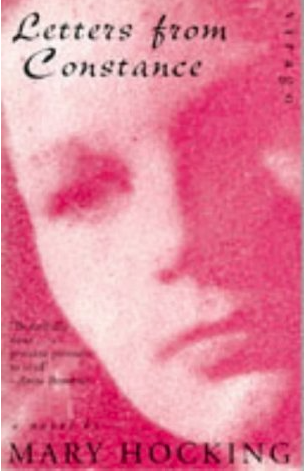
I think it speaks for the quality of a book when you feel like discussing it. Mary Hocking’s Letters From Constance is such a book. There’s so much to discuss. Characters, themes, and even the structure of the book. As the title indicates, Letters From Constance is an epistolary novel. A genre I’m particularly fond of and so it’s not surprising that I liked this novel very much.
Constance and Sheila met when they were only kids, in 1933. They were inseparable during their school years and confident they would stay close in the future. While they stayed close emotionally, they were often separeted. Sometimes for many months, even years. During those times of physical absence, they wrote letters. The novel renders one part of that correspondence that lasted from 1939 to 1984– the letters from Constance to Sheila. Those from Sheila to Constance had to be destroyed. In lesser hands this one-sided correspondence would have felt lacking, but the richness of the letters, the depth of Constance’s analysis and feelings, and her love for her friend, make sure Sheila’s just as present as the writer of the letters.
Constance and Sheila are very different and so are their life choices. While Constance marries an Irishman, Fergus, whom she met while she was posted to Ireland in the WRNS, Sheila marries the musician Miles. Constance has seven children, Sheila has two. Ever since they were teenagers, Sheila wrote poems and Constance was sure she would become a famous poet. It takes decades and a lot of heartache before Sheila finally follows her calling. One could say, she needed a detour to land on her path, while Constance follows her own calling intuitively. There are three things that define Constance – her friendship with Sheila, her children, and her religion.
I was surprised by this book because it’s very different from the first Mary Hocking (The Very Dead of Winter) I read. I must say I loved the first one more – it was richer in atmosphere and descriptions -, but it didn’t make me want to discuss it while this one did. There are so many themes explored it’s hard to name them all. I’ll just pick a few.
Motherhood. Maybe this is the main topic and the way it’s treated is arresting because there are so many elements attached to it. We are introduced to a multitude of mothers. First the mothers of the main protagonists, then the two friends, and finally their friends and daughters. Each woman stands for another type of mother/mothering but – and that’s what’s so great – not one of them is one-dimensional or clichéd.
Love for the children. More interesting than different types of motherhood is how Constance describes herself as a mother. She’s not one mother, but seven different mothers, depending on which child she’s talking about. All the parents of more than one child I know pretend they love all of their children the same. It’s something I’ve a hard time believing and sometimes you just have to listen to them and you know it’s not true. I’m sure they try to treat all of their children the same way, love them all, but there will always be one that’s closer to their heart. Funny enough, when you ask people with siblings, they will tell you that they experienced this, that one was the mother’s favourite, while another one was preferred by the father . . . In the novel Constance, openly names a favorite child. She also says which one she thinks is the most intelligent, the best looking . . . nonetheless she’s just and does love them all. I found that very refreshing, because it’s the way we are. Be it friends, colleagues, siblings, kids, even animals, there’s always one we feel more connected to. I suspect that a lot of heartache comes from our trying to deny this.
The role of women. The novel spans far over half a century and captures the changes in the lives of women, their changing roles, and status. There’s a lot that’s worth discussing here as well.
Religion. While Sheila’s an agnostic, Constance converts to Catholicism. Not because she’s married an Irishman, but because she discovers some writings that help her cope, understand life, and approach it in a more philosophical way. One author who is mentioned is Jean Pierre de Caussade (1675-1751), a French Jesuit priest. I looked him up and what I read sounds very interesting and reminded me a bit of Greek philosopher Epictetus.
The perception of others. For a long time Constance envies Sheila. Her life, her home, her marriage. It sounds freer, more creative. For her, seeing Sheila and her family together, making music, equals a vision of paradise. Over the years we learn that things were very different. I think Mary Hocking touches upon something that happens very often— we haven an idea of people and, eventually, we don’t even see the real people anymore and, through comparison, we don’t even see ourselves.
Structure. This is another of the things I would have loved to discuss. Why did Mary Hocking choose to include only one part of the correspondence? And why did she choose Constance’s? Maybe it’s unfair, but I often thought that Sheila sounded like the more interesting woman.
As I said, I didn’t love this as much as The Very Dead of Winter, even so it is a wonderfully rich novel. One that would make a particularly great choice for a book group. I’m pretty sure it would lead to fascinating discussions.
Unfortunately I don’t know a lot about Mary Hocking. I wonder whether she was more like Constance or more like Sheila – I guess the latter.
This review is part of Heavenali’s Mary Hocking Week. She read and reviewed Letters From Constance last year. Here’s the review.
